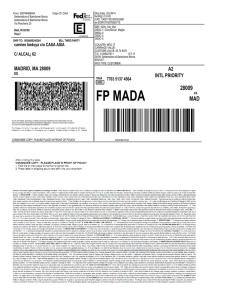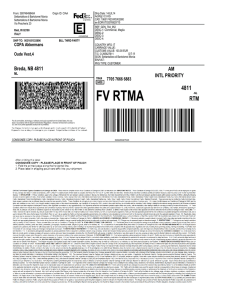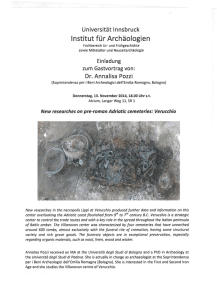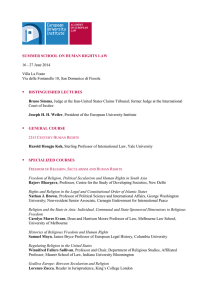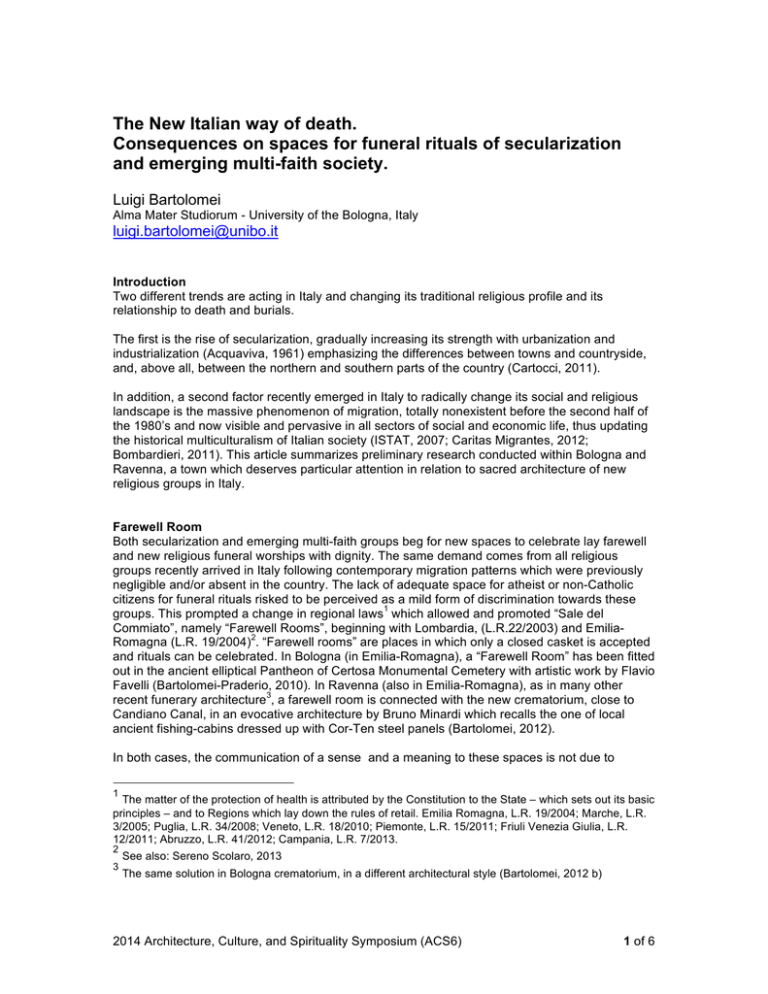
The New Italian way of death.
Consequences on spaces for funeral rituals of secularization
and emerging multi-faith society.
Luigi Bartolomei
Alma Mater Studiorum - University of the Bologna, Italy luigi.bartolomei@unibo.it
Introduction
Two different trends are acting in Italy and changing its traditional religious profile and its
relationship to death and burials.
The first is the rise of secularization, gradually increasing its strength with urbanization and
industrialization (Acquaviva, 1961) emphasizing the differences between towns and countryside,
and, above all, between the northern and southern parts of the country (Cartocci, 2011).
In addition, a second factor recently emerged in Italy to radically change its social and religious
landscape is the massive phenomenon of migration, totally nonexistent before the second half of
the 1980’s and now visible and pervasive in all sectors of social and economic life, thus updating
the historical multiculturalism of Italian society (ISTAT, 2007; Caritas Migrantes, 2012;
Bombardieri, 2011). This article summarizes preliminary research conducted within Bologna and
Ravenna, a town which deserves particular attention in relation to sacred architecture of new
religious groups in Italy.
Farewell Room
Both secularization and emerging multi-faith groups beg for new spaces to celebrate lay farewell
and new religious funeral worships with dignity. The same demand comes from all religious
groups recently arrived in Italy following contemporary migration patterns which were previously
negligible and/or absent in the country. The lack of adequate space for atheist or non-Catholic
citizens for funeral rituals risked to be perceived as a mild form of discrimination towards these
1
groups. This prompted a change in regional laws which allowed and promoted “Sale del
Commiato”, namely “Farewell Rooms”, beginning with Lombardia, (L.R.22/2003) and Emilia2
Romagna (L.R. 19/2004) . “Farewell rooms” are places in which only a closed casket is accepted
and rituals can be celebrated. In Bologna (in Emilia-Romagna), a “Farewell Room” has been fitted
out in the ancient elliptical Pantheon of Certosa Monumental Cemetery with artistic work by Flavio
Favelli (Bartolomei-Praderio, 2010). In Ravenna (also in Emilia-Romagna), as in many other
3
recent funerary architecture , a farewell room is connected with the new crematorium, close to
Candiano Canal, in an evocative architecture by Bruno Minardi which recalls the one of local
ancient fishing-cabins dressed up with Cor-Ten steel panels (Bartolomei, 2012).
In both cases, the communication of a sense and a meaning to these spaces is not due to
1
The matter of the protection of health is attributed by the Constitution to the State – which sets out its basic
principles – and to Regions which lay down the rules of retail. Emilia Romagna, L.R. 19/2004; Marche, L.R.
3/2005; Puglia, L.R. 34/2008; Veneto, L.R. 18/2010; Piemonte, L.R. 15/2011; Friuli Venezia Giulia, L.R.
12/2011; Abruzzo, L.R. 41/2012; Campania, L.R. 7/2013.
2
See also: Sereno Scolaro, 2013
3
The same solution in Bologna crematorium, in a different architectural style (Bartolomei, 2012 b)
2014 Architecture, Culture, and Spirituality Symposium (ACS6)
1 of 6
religious symbols but indeed only to art (Bartolomei, 2011a). Art strengthens the versatility which
is requested of these new spaces for funeral rituals with regards to both symbols, and spatial
configurations. Farewell rooms can indeed act as scenography for different religious rituals and
also for lay ones whose liturgy changes from time to time in the attempt to adhere to and
celebrate the historical and psychological personality of the deceased (Bartolomei-Praderio,
2010).
“Case funerarie” or “Funeral Homes”
The growing incomprehension of the anagogical and esoteric language of the liturgy, specifically
4
the Christian one, can be considered one of the main reasons for the need of new liturgies to
customize the last farewell. What is required is the possibility to celebrate the specific personality
of the deceased (Sozzi, 2001), and thus inevitably reflect the contemporary trend in a renewed
attention to the body, which is without doubt one of the most evident tracks of the singularity of
each individual life.
Hence, farewell rooms immediately reveal their limits since the casket must be closed;
furthermore this is already possible in any public or private space, upon authorization from the
municipality.
It is because of this attention to the body that more and more obituaries and morgues recently
became spaces for prayer, rituals, sharing of intimate feelings and emotions although these
spaces were originally developed for the scientific observation of corpses. In these new
conditions, they suddenly show their completely inappropriateness, both in relation to their size
5
and their ambiance .
Within an urban context, the average apartment does not allow for a traditional farewell space
within the home. Thus, it has become common practice to bring the deceased to hospital
morgues. In addition, most deaths typically occur in hospitals (Pinkus, Filiberti, 2002; Monti,
2010). It is because of these conditions that many private funerary enterprises are building
“Funeral Homes”. This is undeniably the most relevant news in the Italian market of funerals and
in the taxonomy of architectural Italian typologies. In fact, for the first time in Italian history, funeral
homes are private buildings which absolve the functions of observation previously typical and
proper only of public institutions. Despite the fact that all regional laws introducing “farewell
6
structures” underline that they must be open to everyone, funeral homes are indeed the first
private structure for rituals in Italy. Inside these structures it is possible to celebrate those rituals
which were once celebrated inside the home as, for example, funeral wakes, or lay last sight to
the dead. The funerary Mass however, is not allowed in such spaces, as the Bishop of Modena
established as soon as one of the most prestigious funeral home in Italy opened in his Diocese
(Bartolomei 2011 b):
“To celebrate the funeral it is required to go into the Parish of the deceased […]” and, in
any case, “it is not possible to celebrate funeral rituals in mortuaries or burial chambers
7
[…] or in other spaces also used for non-Christian or lay rituals” .
4
Already denounced by the Italian Conference of Bishops (CEI) in 1983, that is twenty years after
Sacrosanctum Concilium (CEI, 1983)
5
As it has been recently shown by a 2009 research on hospital morgues, coordinated in Piemonte by
Rossana Becarelli, avaiable at http://www2.aress.piemonte.it/cms/umanizzazione-documenti.html
6
Only Veneto, Friuli-Venezia-Giulia and Abruzzo have now a legislation which distinguish funeral homes
from farewell rooms.
7
Antonio Lanfranchi, Vescovo di Modena e Nonantola, Istruzione sul luogo di celebrazione dei Funerali, 24
2014 Architecture, Culture, and Spirituality Symposium (ACS6)
2 of 6
Completely unknown in the Italian landscape until 1995, there are now more than 100 Italian
Funeral homes, the majority within the northern part of the country, conquering sub-urban or
industrial areas, declaring a general reference to an unspecified American model of management
but without the same possibility of customization. many cases are merely simple extensions of
industrial warehouses where funerary companies store their cars. Furthermore, there is a
complete separation between the obituaries spaces and the ritual ones, and yet even examples
which attempt a more elevated design, often present a collection of bourgeoisie decor.
image 1: Actual distribution of Funeral homes in Italy (2014) in relation to regions. (Source
www.casefunerarie.it)
3 . Transformations in cemeteries
Secularization and multi-faith societies are challenging the architecture and the organization of
cemeteries, which in Italy, for the most part belong to municipalities (Bertolaccini, 2004). Urban
cemeteries are becoming mosaics of different burial traditions, organizing themselves in a
“Cluster geometry” (Bartolomei, 2012). The main cause of this new fragmentation in the inner
8
space of ancient cemeteries is due to the possibility offered by the National Law (DPR 285/1990)
to foreign communities and to all religious groups other than Catholic to ask municipalities for
special burial places in cemetery zoning. This law appears to favor minority groups since it is
assumed that Italian cemeteries will remain predominantly catholic. However, this is not the case
in Italy today, due to both secularization and the waning political power of Catholicism which has
Giugno 2011
8
DPR 285/1990, art. 100 : “1. Cemetery zoning [...] may provide special and separated wards for burial of
dead people professing a religion other than Catholic. 2. To foreign communities who claim for a special
department for the burial of the bodies of their contrymen, an appropriate cemetery area can also be given in
licence by the mayor”
2014 Architecture, Culture, and Spirituality Symposium (ACS6)
3 of 6
definitively lost its qualification as State Religion in 1984 with the revision of Lateran Pacts
(Cavana, 2009).
Karl Scheffler seems to be almost a prophet when, in his 1913 work “The Architecture of
Metropolis”, states: “soon there will be no Catholics, Protestants or Jews cemeteries at all but
only civic central cemeteries, as soon as epochal tendencies will gain the upper hand. The
Church loses more and more its dominion over the cemetery, since, instead of the blessing of the
priest, seeks only the public display of the body. Municipalities get the upper hand on the
9
legacies” .
If, on one hand, the fragmentation of cemeteries reflects that of towns, from another point of view
it collaborates to reduce their cultural and spiritual identity, discouraging their use and favoring
new rituals and places for burial. On the other hand, if within lay spirituality, the private custody of
ashes or their dispersion in nature can be interpreted in several cases as an escape from
unsatisfactory burial alternatives; catholic parishes have begun to demonstrate a particular care
for mortal remains and special places for urns within churches. This option is of particular interest
with respect to theological and liturgical considerations (Chenis, 2006) because of the evidence
and somewhat visible closeness you might perceive between the living Church and the celestial
one in the same place of Eucharist.
This choice to favor ashes chapels could be promoted by other religious groups or lay
associations hence re-introducing the dead inside towns and permitting again the living to dwell
closer to the tombs of the fathers, thus re-discovering an ancient tradition.
image 2: The new crypt for ashes in San John The Baptist Parish in Montecalvo (Bologna – Photo by Luca Melechi)
9
Scheffler, Karl. L’architettura della metropoli e altri scritti sulla città (Milano: Franco Angeli ed., 2013, p.
125) [orig. Ed. Berlino: Bruno Cassirer Berlag,1913], work already wellknown in Italy thanks to M. Cacciari’s
essay “Metropolis. Saggi sulla grande città in Sombart, Endell, Scheffer e Simmel”, ed. Officina, Roma, 1973
2014 Architecture, Culture, and Spirituality Symposium (ACS6)
4 of 6
image 3: Architecture for ashes inside St. Joseph Church in Aachen (Germany - Photo by Tino Grisi)
2014 Architecture, Culture, and Spirituality Symposium (ACS6)
5 of 6
4. Conclusions
Despite their different origins, vocation and identity, which this paper would like to focus on and
distinguish, both farewell rooms, new Italian funeral homes and colombariums for ash storage,
converge in rejoining the city of the dead with the one of the living. This inverting trend which
since the time of Enlightenment, ostracized dead from urban boundaries, founding death as one
of the most significant taboo in European Society (Aries, 1975).
The indirect results of secularization and of new emerging multi-faith societies allude to the
reconciliation between death and life which is the most important result of this new way of Italian
death.
References
Acquaviva, Sabino. L’eclissi del sacro nella civiltà industriale (Milano: Edizioni di Comunità, 1961)
Aries, Philippe. Essais sur l'histoire de la mort en occident: du moyen age a nos jours (Paris: Editions du
Seuil, 1975)
Bertolaccini, Laura. Città e cimiteri: dall'eredità medievale alla codificazione ottocentesca (Roma: Kappa,
2004)
Bartolomei, Luigi e Giorgio Praderio. New architectures for funeral houses in contemporary secularized
Italian society. Premises and results of an interdisciplinary university research activity, in “Annales
Universitatis Apulensis, Series Historica” (Alba Iulia: Special Issue 2/2010, pages: 469/480, 2010)
Bartolomei, Luigi (2011 a). Places for a cult of memories in the Italian post-secular city, in “Annales
Universitatis Apulensis, Series Historica” (Alba Iulia: Special Issue, 2011)
Bartolomei, Luigi (2011 b). “A Modena la seconda Funeral Home italiana”, in Il Giornale dell’Architettura,
(Torino: Allemandi editore, Ottobre 2011, n.98, p.5)
Bartolomei, Luigi (2012 a). Evoluzioni contemporanee nell’architettura funeraria (Bologna: CSO, 2012)
Bartolomei, Luigi (2012 b). “A Bologna il nuovo Crematorio”, in Il Giornale dell’Architettura, (Torino:
Allemandi editore, Dicembre 2012, n.99, p. 3)
Bombardieri, Maria. Moschee d'Italia: il diritto al luogo di culto. Il dibattito sociale e politico (Bologna: EMI,
2011)
Caritas e Migrantes. Immigrazione: dossier statistico 2012: 22° rapporto sull'immigrazione, (Roma: IDOS,
2012).
Cartocci, Roberto. Geografia dell'Italia cattolica (Bologna: Il Mulino, 2011)
Cavana, Paolo. Mutamenti culturali ed evoluzione legislativa in Italia. In Strada, Gabriele (ed.) La morte e i
suoi riti per una celebrazione cristiana dei funerali. Atti del convegno regionale di Imola 1-2 giugno
2009. (Reggio Emilia: edizioni san Lorenzo, 2009, pp. 51-53)
CEI- Episcopal Commission for Liturgy. Il rinnovamento liturgico in Italia, 23 Settembre 1983, also avaiable
on http://www.chiesacattolica.it/
Chenis, Carlo. Evangelizzare la cremazione per una icona della Chiesa. I termini della legge 130 del 30
Marzo 2001, in Rivista Liturgica, n.5, pp. 756-780. (Padova: edizioni il Messaggero,
September/October 2005)
Istat, Indagine conoscitiva sulla immigrazione e l’integrazione, inquiry presented at the Audizione dell’Istituto
Nazionale di Statistica presso il “Comitato Parlamentare italiano di Controllo sull’attuazione
dell’Accordo di Schengen, di vigilanza sull’attività di Europol, di controllo e vigilanza in materia di
immigrazione”, Roma, 21 febbraio 2007.
Lanfranchi, Antonio (Bishop of Modena and Nonantola), Istruzione sul luogo di celebrazione dei funerali.
In Modena, June 24th 2011, also avaiable on http://www.webdiocesi.chiesacattolica.it
Monti, Daniela (ed.). Che cosa vuol dire morire (Torino: Einaudi, 2010)
Pinkus, Lucio and Filiberti, Antonio (eds.). La qualità della morte (Milano: Franco Angeli ed, 2002)
Sozzi, Marina (ed.). La scena degli addii: morte e riti funebri nella società occidentale contemporanea: atti
del convegno svoltosi a Torino il 24 e 25 settembre 1999. (Torino, Paravia Scriptorium, 2001)
Scolaro, Sereno. Manuale di polizia mortuaria. La disciplina nazionale e regionale, (Sant’Arcangelo di
Romagna: Maggioli ed., 2013)
2014 Architecture, Culture, and Spirituality Symposium (ACS6)
6 of 6

